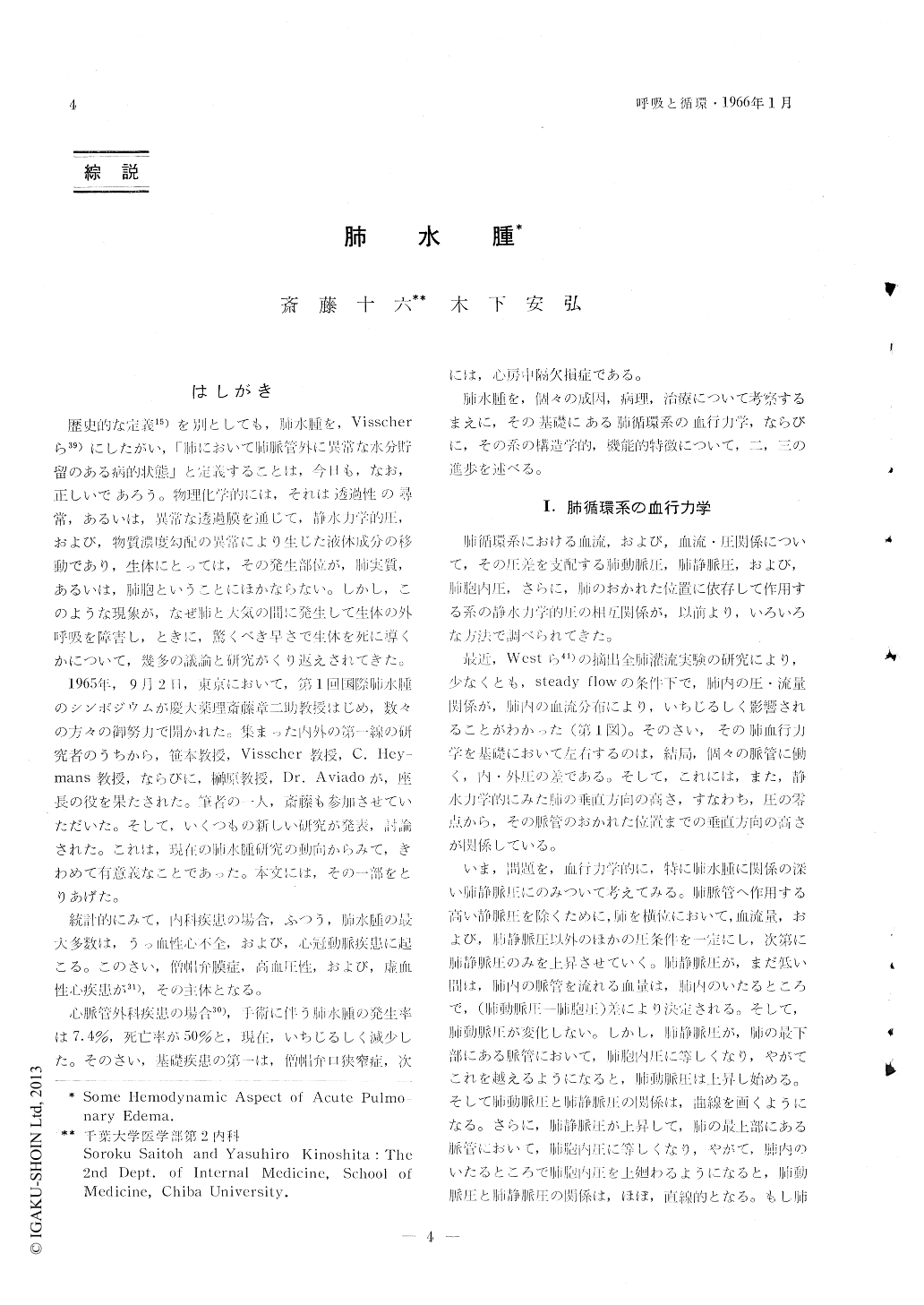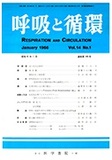Japanese
English
- 有料閲覧
- Abstract 文献概要
- 1ページ目 Look Inside
はしがき
歴史的な定義15)を別としても,肺水腫を,Visscherら39)にしたがい,「肺において肺脈管外に異常な水分貯留のある病的状態」と定義することは,今日も,なお,正しいであろう。物理化学的には,それは透過性の尋常,あるいは,異常な透過膜を通じて,静水力学的圧,および,物質濃度勾配の異常により生じた液体成分の移動であり,生体にとっては,その発生部位が,肺実質,あるいは,肺胞ということにほかならない。しかし,このような現象が,なぜ肺と大気の間に発生して生体の外呼吸を障害し,ときに,驚くべき早さで生体を死に導くかについて,幾多の議論と研究がくり返えされてきた。
1965年,9月2日,東京において,第1回国際肺水腫のシンポジウムが慶大薬理斎藤章二助教授はじめ,数々の方々の御努力で開かれた。集まった内外の第一線の研究者のうちから,笹本教授,Visscher教授,C.Hey—mans教授,ならびに,榊原教授,Dr.Aviadoが,座長の役を果たされた。筆者の一人,斎藤も参加させていただいた。そして,いくつもの新しい研究が発表,討論された。これは,現在の肺水腫研究の動向からみて,きわめて有意義なことであった。本文には,その一部をとりあげた。
Pulmonary edema has been produced by various agents and methods in experimental animals. The present investigation reviewed recent advances in this field of medicine. It also attempted to elucidate the hemodyna-mic importance of blood pressure regulation in the development of acute pulmonary edema.
Mongrel dog were anesthetized with in-travenous pentobarbital sodium (25 mg/kg). Under positive pressure respiration of 95% of oxygen plus 5% carbon dioxide, left thoracotomy was performed at the fourth intercostal space. Left pulmonary arterial (PA) and venous (PV) pressures, left atrial (LA) pressure, right ventricular (RV) pres-sure and fomoral arterial(FA) pressure were determined at a control state and during a rapid intravenous infusion of epinephrine (0.5 to 1.0 mg/kg) plus normal saline solu-tion (38 to 39℃, 2,500 ml). At autopsy the lungs were examined grossly on the grade of pulmonary edema. Fixed specimens of the lungs were stained with hematoxylin-eosin and PAS for microscopic examination.
One of the representative cases was shown in Fig. 4. After the infusion of the first 500 ml of the solution, the mean femoral arterial pressure rose from 85 to 104 mmHg, i. e., 22% increase. The mean pulmonary arterial pressure was elevated from 22 to 48 mmHg, i. e., by 118%. The pulse pressure of the pulmonary arterial pressure was in-creased from 29 to 37 mmHg. The mean pul-monary venous pressure was raised noticeably from 8.3 to 21 mmHg. The mean left atrial pressure was also raised from 7.3 to 18.5mm Hg. The right systolic ventricular pressure and the heart rate (120 per minute) were increased by 44% and 25% respectively. During the whole period of the infusion, the enormous elevation of the pulmonary arterial and venous pressures, left atrial pressure and the right systolic ventricular pressure was persisted as well as tachycardia.
Microscopic examination revealed a marked edema of perivascular interstitial tissue which extended to peribronchial tissue. These interstitial tissues and alveoli were filled with PAS-stained substance (Fig. 5, 6).
Pulmonary edema with infusion of opine-phrine plus normal saline solution may be developed by enormous and almost simulta-neous pressure rises in the systemic and pul-monary circulatory systems which may oppose and overcome various counteractions of de-pressor regulatory mechanism. The sudden onset and persistence of uncontrollable high pressure in the low pressure system, being unable to reestablish effective regulatory mechanism, may lead to extravasation into the system.
Some topics were discussed at the first international symposium on pulmonary edema and pulmonary circulation in Tokyo.

Copyright © 1966, Igaku-Shoin Ltd. All rights reserved.


